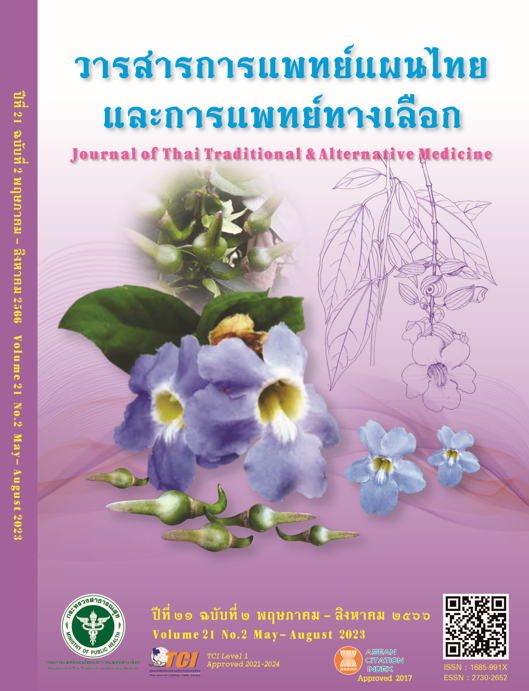Safety Evaluation of Rhinacanthus nasutus Root Extract Gel Prepared from a Pilot Plant
Main Article Content
Abstract
Introduction and objective: Rhinacanthus nasutus (commonly known as thong phan chang in Thai) root extract gel preparation, containing 0.1% rhinacanthin C, is an herbal product that was developed as an effective topical agent for fungal skin infection using knowledge from both scientific research and Thai traditional medicine. However, the safety of a novel herbal preparation should be assessed before it is approved for use in humans. This study aimed to evaluate the safety of R. nasutus root extract gel preparation prepared in a pilot plant.
Methods: Safety study of R. nasutus root extract gel was conducted following the Organisation for Economic Co-operation and Development (OECD) Guidelines, including the bacterial reverse mutation test (Test Guideline 471) and the acute dermal irritation/corrosion test (Test Guideline 404). Skin irritation testing in healthy Thai volunteers was performed using a single patch test.
Results: Topical preparation of R. nasutus root extract was not found to cause any mutations in bacteria, nor did it irritate or corrode the animal skin. Moreover, it did not cause any skin reactions in healthy volunteers during the single patch test.
Discussion: R. nasutus root extract gel preparation, containing 0.1% rhinacanthin C, is categorized as an herbal product derived from research and development beyond traditional knowledge. Thus, the product needs safety and efficacy data from animal models and humans for product registration. In order to study the safety profile of the product according to international standards, the results suggest the R. nasutus root extract gel had non-genotoxic and non-skin corrosive effects, nor did it cause dermal irritation in both animal models and humans.
Conclusion and recommendation: R. nasutus root extract gel preparation is deemed to be safe for humans and we can further proceed to clinical trials for efficacy and safety evaluations in patients with fungal skin infections.
Article Details

This work is licensed under a Creative Commons Attribution-NonCommercial-NoDerivatives 4.0 International License.
References
Thiangburanathum W. Dictionary of Thai medicinal plants. 5th ed. Bangkok: Aksornpittaya; 1999. (in Thai)
Thailand Association of Traditional Medicine School Wat Phra Chetuphon (Wat Pho) Tha Thien Pranakorn. Handbook of Thai pharmacist drug Act B.E. 2510 and ministerial regulation. 2nd ed. Bangkok: Ampolpittaya; 1869. (in Thai)
Bukke S, PS R, GS, Kedam TR. The study on morphological, phytochemical and pharmacological aspects of Rhinacanthus nasutus. (L) Kurz (A Review). J App Pharm Sci. 2011;1(8):26-32.
Kodama O, Ichikawa H, Akatsuka T, Santisopasri V, Kato A, Hayashi Y. Isolation and identification of an antifungal naphthopyran derivative from Rhinacanthus nasutus. J Nat Prod. 1993;56(2):292-4.
Pruksakorn P, Jaima C, Panyajai P, Mekha N, Autthateinchai R, Dhepakson P. Antifungal activity of Rhinacanthus nasutus (L.) Kurz extract against dermatophytes. J Thai Trad Alt Med. 2018;16(2):205-17. (in Thai)
Siripong P, Wongseri V, Piyaviriyakul S, Yahaufai J, Chanpai R, Kanokmedakul K. Antibacterial potential of Rhinacanthus nasutus against clinically isolated bacteria from Thai cancer patients. Mahidol J Pharm Sci. 2006;33(1-4):15-22.
Sendl A, Chen JL, Jolad SD, Stoddart C, Rozhon E, Kernan M, Nanakorn W, Balick M. Two new naphthoquinones with antiviral activity from Rhinacanthus nasutus. J Nat Prod. 1996;59(8):808-11.
Thongchuai B, Tragoolpua Y, Sangthong P, Trisuwan K. Antiviral carboxylic acids and naphthoquinones from the stems of Rhinacanthus nasutus. Tetrahedron Lett. 2015;56(37):5161-3.
Bhusal N, Panichayupakaranant P, Reanmongkol W. In vivo analgesic and anti-inflammatory activities of a standardized Rhinacanthus nasutus leaf extract in comparison with its major active constituent rhinacanthin-C. Sonklanakarin J Sci Technol. 2014;36(3):325-31.
Tewtrakul S, tansakul P, Panichayupakaranant P. Effects of rhinacanthins from Rhinacanthus nasutus on nitric oxide, prostaglandin E2 and tumor necrosis factor-alpha releases using RAW264.7 macrophage cells. Phytomedicine. 2009;16(6-7):581-5.
Tewtrakul S, Tansakul P, Panichayapakaranant P. Anti-allergic principles of Rhinacanthus nasutus leaves. Phytomedicine. 2009;16:929-34.
Darah I, Jain K. Efficacy of the Rhinacanthus nasutus Nees Leaf extract on dermatophytes with special reference to Trichophyton mentagrophytes var. mentagrophytes and Microsporum canis. Nat Prod Sci. 2001;7(4):114-9.
Deepa N, Ravichandran V. Anti-fungal activity of various extracts of Rhinacanthus nasutus (I). Kurtz. Nat Prod Indian J. 2008;4(2):125-7.
Wisuitiprot W. Antifungal activity of Rhinacanthus nasutus extract against Malassezia sp. J Health Sci. 2012;21(3):521-8. (in Thai)
Bureau of Drug Control, Food and Drug Administration. National list of essential medicines 2013. Bangkok: The Agricultural Co-operative Federation of Thailand Printing Press, Ltd.; 2013. (in Thai)
Pruksakorn P, Jaima C, Sumateewatanakul V, Sa-nguanruang W, Panyajai P, Autthateinchai R, Mekha N, Sachanonta N, Dhepakson P. Development and evaluation of Rhinacanthus nasutus root extract gel as an antifungal for the treatment of dermatophytosis. J Thai Trad Alt Med. 2021;19(2):435-57. (in Thai)
OECD guideline for testing of chemicals. Bacterial reverse mutation test. [Internet]. 2020 [cited 2022 Dec 9]; [12 pages]. Available from: https://www.oecd-ilibrary.org/ docserver/9789264071247-en.pdf?expires=1670388034&id=id&accname=guest&checksum=46C91D89F66D5860DAAE9CE558ADB2EE
OECD guideline for testing of chemicals. Acute dermal irritation/ corrosion. [Internet]. 2015 [cited 2022 Dec 6]; [8 pages]. Available from: https://www.oecd-ilibrary.org/docserver/9789264242678-en.pdf?expires=1670390038&id=id& accname=guest&checksum=02AF5206A58CB39F482A45498B3D0D0D
OECD series on testing and assessment Number 33. Harmonised integrated classification system for human health and environmental hazards of chemical substances and mixtures. [Internet]. 2001 [cited 2022 Dec 6]; [247 pages]. Available from: https://www.oecd.org/official documents/publicdisplaydocumentpdf/?cote=env/jm/mono(2001)6&doclanguage=en
Cosmetics Europe. Product test guideline for the assessment of human skin compatibility. [Internet]. 1997 [cited 2022 Dec 7]; [26 pages]. Available from: https://www. cosmeticseurope.eu/files/6014/6407/8875/Product_Test_Guidelines_for_the_Assessment_of_Human_Skin_Compatibility_-_1997.pdf
Mulyanti YS, Yuliarni, Kasemchainan B, Mitra PP, Evans P, Hartono H. Evaluation of the skin irritation and sensitization potential of the Cussons baby sensicare skin range of products in healthy volunteers. J Cosmet Dermatol Sci Appl. 2019;9:207-15.
Roussel CQ, Poncet M, Mesaros S, Clucas A, Baker M, Soloff AM. Comparison of the cumulative Irritation potential of adapalene gel and cream with that of erythromycin/tretinoin solution and gel and erythromycin/isotretinoin gel. Clin Ther. 2001;23(2):205-12.
British Pharmacopoeia Commission. British Pharmacopoeia 2018. London: TSO; 2017.
Bureau of Drug and Narcotic, Department of Medical Sciences. Thai Herbal Pharmacopoeia 2019 Vol. I and II. Nonthaburi: Bureau of Drug and Narcotics, Department of Medical Sciences, Ministry of Public Health; 2019.
Herbal product division, Thai Food and Drug Administration. Guideline for preparing documents for herbal product license in low-risk cases. [Internet]. 2021 [cited 2023 Jan 7]; [75 pages]. Available from: https://www.fda.moph.go.th/Herbal/SitePages/Document/product/3.product_allow.pdf


